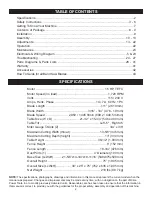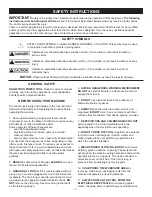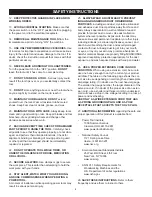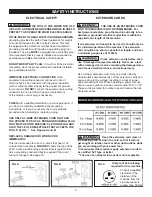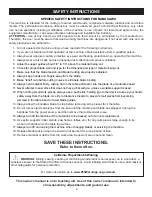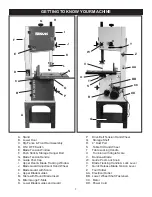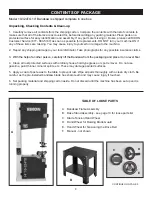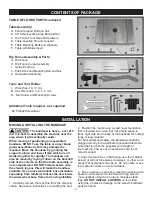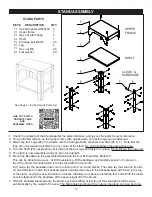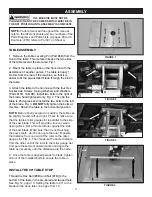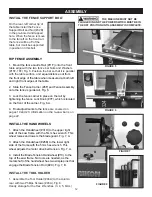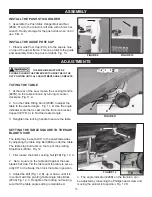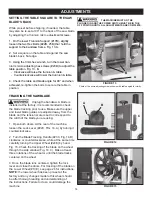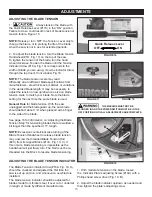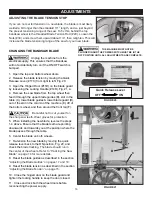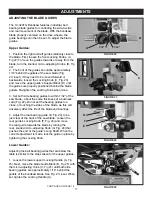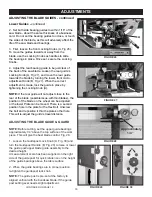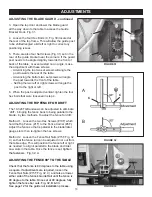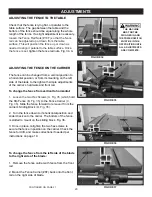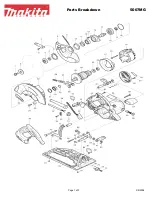
5
SAFETY INSTRUCTIONS
COVER
RAILS
FIG. B
FIG. A
THE USE OF AN EXTENSION CORD
WITH THIS MACHINE IS NOT RECOMMENDED. For
best power and safety, plug the machine directly into a
dedicated, grounded electrical outlet that is within the
supplied cord length of the machine.
If an extension cord needs to be used, it should only be
for a limited operation of the machine. The extension
cord should be as short as possible in length, and have
a minimum gauge size of 14AWG.
Check extension cords before each
use. If damaged replace immediately. Never use a tool
with a damaged cord, since touching the damaged area
could cause electrical shock, and serious injury.
Use a proper extension cord. Only use cords listed by
Underwriters Laboratories (UL). Other extension cords can
cause a drop in line voltage, resulting in a loss of power
and overheating of tool. When operating a power tool out-
doors, use an outdoor extension cord marked “W-A” or “W”.
These cords are rated for outdoor use and reduce the risk
of electric shock.
DO NOT MODIFY ANY PLUG.
If it will not fit the electrical
receptacle, have the proper electrical receptacle installed
by a qualified electrician.
IMPROPER ELECTRICAL CONNECTION
of the
equipment grounding conductor can result in risk of
electric shock. The conductor with the green insulation
(with or without yellow stripes) is the equipment ground-
ing conductor.
DO NOT
connect the equipment grounding
conductor to a live terminal if repair or replacement
of the electric cord or plug is necessary.
CHECK
with a qualified electrician or service personnel if
you do not completely understand the grounding
instructions, or if you are not sure the tool is properly
grounded when installing or replacing a plug.
USE ONLY A 3-WIRE EXTENSION CORD THAT HAS
THE PROPER TYPE OF A 3-PRONG GROUNDING PLUG
THAT MATCHES THE MACHINE’S 3-PRONG PLUG AND
ALSO THE 3-POLE RECEPTACLE THAT ACCEPTS THE
TOOL’S PLUG. * See Figures A and B.
REPLACE A DAMAGED OR WORN CORD
IMMEDIATELY.
This tool is intended for use on a circuit that has a 120
volt electrical receptacle.
FIGURE C
shows the type of the
220V, 3-wire electrical plug and electrical receptacle that
has a grounding conductor that is required if the motor
wiring is changed. See page 23.
IN THE EVENT OF A MALFUNCTION OR BREAKDOWN,
grounding provides the path of least resistance for electric
current and reduces the risk of electric shock. This tool
is equipped with an electric cord that has an equipment
grounding conductor and requires a grounding plug (not
included). The plug
MUST
be plugged into a matching elec-
trical receptacle that is properly installed and grounded in
accordance with
ALL
local codes and ordinances.
ELECTRICAL SAFETY
THIS TOOL IS PRE-WIRED FOR 115V
CIRCUITS, AND MUST BE GROUNDED WHILE IN USE TO
PROTECT THE OPERATOR FROM ELECTRIC SHOCK.
Sample of 230 volt plug
required for this machine.
EXTENSION CORDS
Keep the extension cord clear of
the working area. Position the cord so that it will not
get caught on lumber, tools or other obstructions while
you are working with your power tool.
* Canadian electrical codes require extension cords to
be certified SJT type or better.
** The use of an adapter in Canada is not acceptable.
Consult a qualified
electrician if the
distance of the
machine from the
electrical panel is
greater than 30 feet.
FIG. C
Summary of Contents for 10-324TG
Page 43: ...43 OPERATION...


